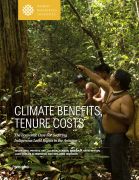Carbon and the fate of the Amazon
This publication shows that carbon prices exceeding US$ 20 per ton of CO2 captured by the natural regeneration of deforested areas in the Amazon would be truly transformative for the region’s landscape.
This publication shows that carbon prices exceeding US$ 20 per ton of CO2 captured by the natural regeneration of deforested areas in the Amazon would be truly transformative for the region’s landscape.
<p>We mapped the inferred long-distance migrations of four species of Amazonian goliath catfishes (Brachyplatystoma rousseauxii, B. platynemum, B. juruense and B. vaillantii) based on the presence of individuals
The Economics of Adaptation: Concepts, Methods and Examples is a guide for practitioners to assess economic benefits and costs of avoiding climate change damages through adaptation by developing these
<p>Mosquito-borne viruses threaten public health worldwide. When the ratio of competent vectors to susceptible humans is low enough, the virus’s basic reproductive number (R0) falls below 1.0 (each
Reconstructing the history of tropical hydroclimates has been difficult, particularly for the Amazon basin—one of Earth’s major centres of deep atmospheric convection. For example, whether the Amazon basin
<p><img alt="" src="http://www.indiaenvironmentportal.org.in/media/iep/homepage/wild_bio_17.jpg" style="width: 280px; height: 210px; margin: 14px; float: left;" />A new study published in the journal Nature
An oil spill was detected on November 13th on the Teles Pires River, a tributary of the Tapajós River, in a remote part of the Brazilian Amazon. The spill occurred near the under-construction São Manoel
There are 14 different ecosystems in Manu National Park, a defining characteristic of its high biodiversity. Peru’s Manu National Park has claimed the distinction as the place with the greatest terrestrial
Cattle ranching in Brazil is a key driver of deforestation and greenhouse gas (GHG) emissions. The Brazilian government plans to reduce national GHG emissions by at least 36%, partly by reducing emissions

A new report offers evidence that the modest investments needed to secure land rights for indigenous communities will generate billions in returns—economically, socially and environmentally—for local communities
Infrastructure projects designed to open the western Amazon for investment are to blame for deforestation in parts of Peru, Colombia and Bolivia - rather than coca production, researchers said on Wednesday.